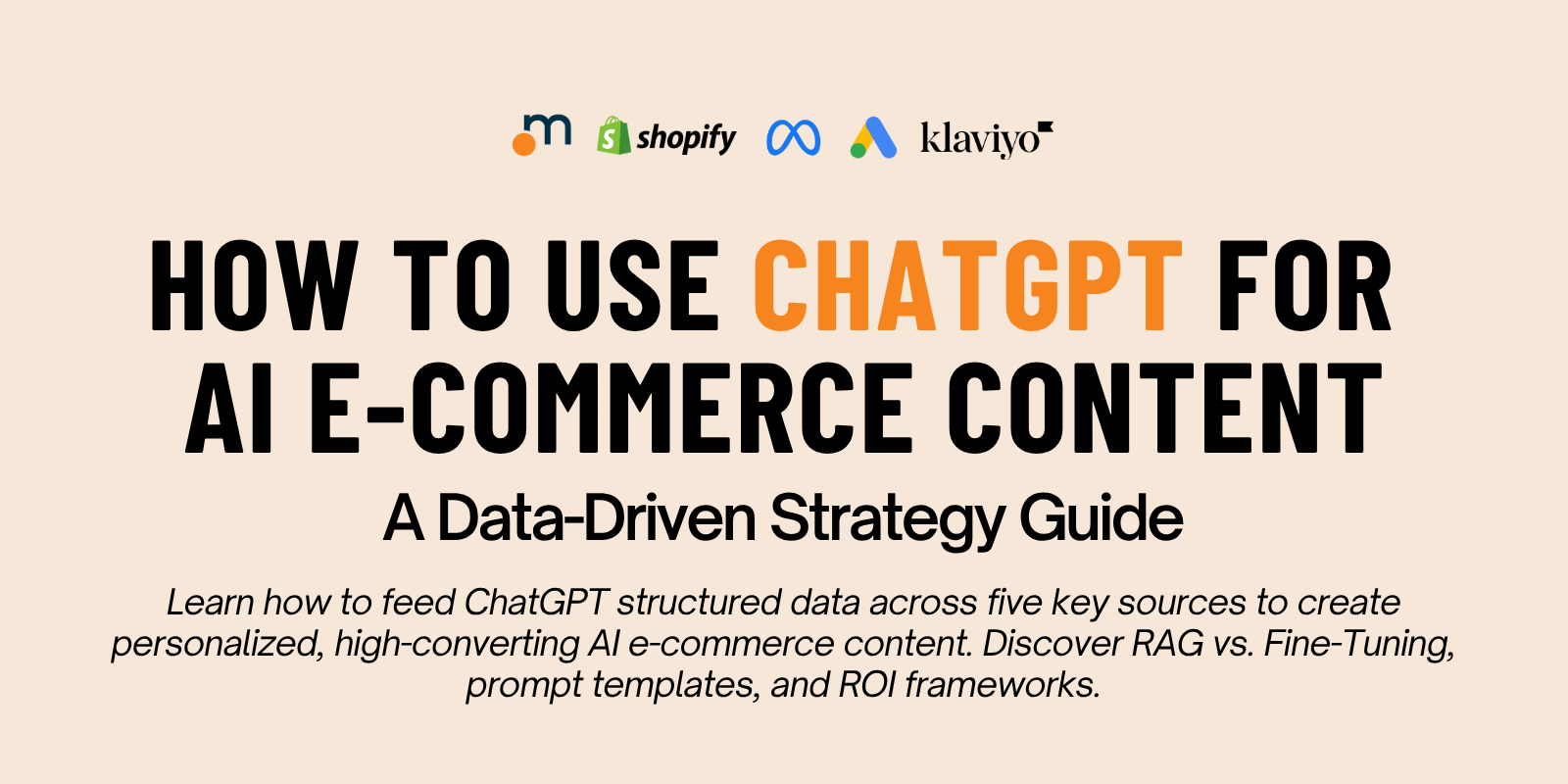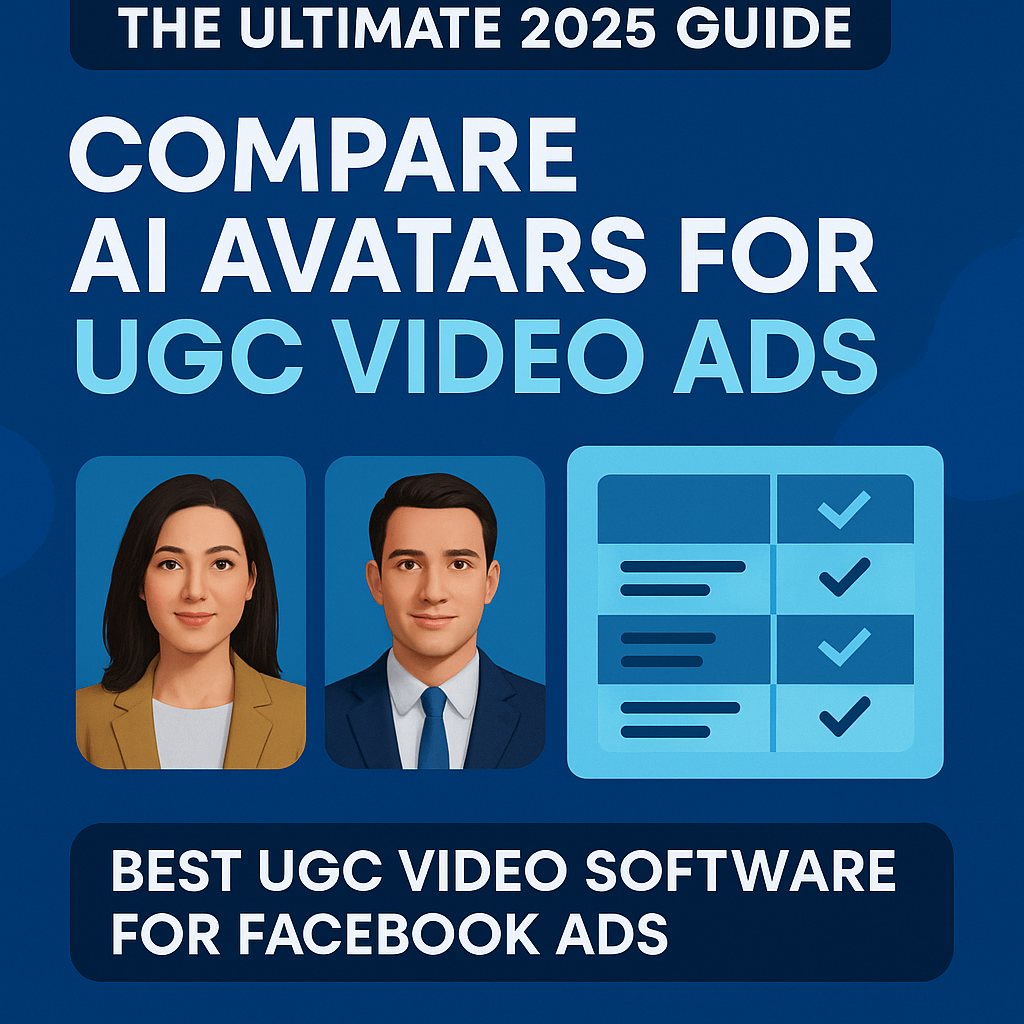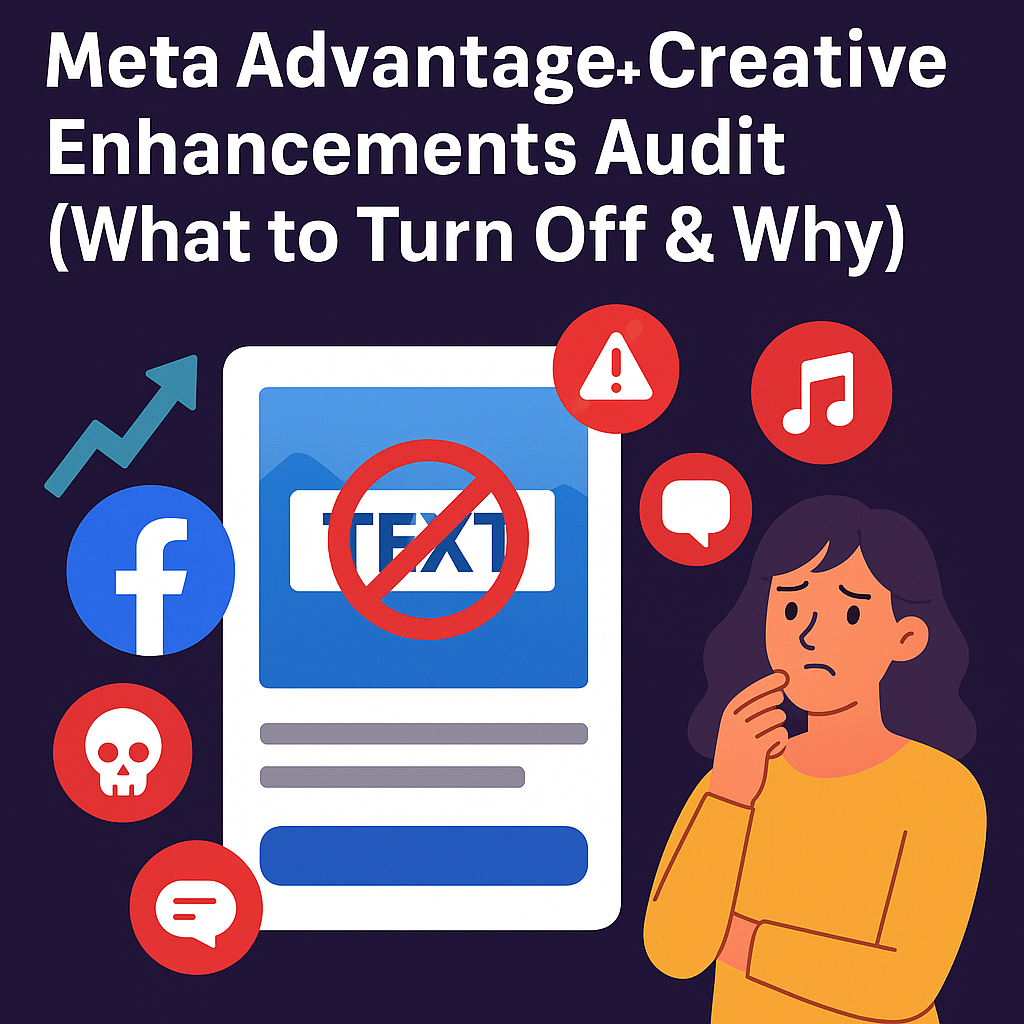Want ChatGPT to generate better e-commerce content? This guide shows how to feed it structured data from 5 sources, Voice of Customer, Performance Metrics, Customer Interactions, Psychographics, and Cultural Signals, using tools like Zapier, GA4, and more. Includes prompt templates, data pipelines, and ROI tracking.
Why AI-Driven Content is Essential for E-commerce Growth
E-commerce is no longer competing solely on price or product; content is the new battleground. With the global e-commerce market projected to exceed $6.8 trillion by 2025 (Statista), the pressure to attract, convert, and retain customers has never been higher. And content, whether in the form of product descriptions, ad copy, or emails, plays a pivotal role in that process.
At the same time, the AI market is expected to reach $191 billion by 2025, signaling a massive shift in how digital experiences are created and scaled. Brands that adopt AI tools like ChatGPT to generate personalized content are seeing:
- 2–3x faster content production cycles
- Lifted engagement metrics (CTR, time on page)
- Improved Return on Ad Spend (ROAS)
However, most e-commerce brands use AI with generic prompts, resulting in generic outputs. AI alone isn’t a strategy. Data is.
The key differentiator isn’t whether you’re using ChatGPT; it’s what you feed it. A data-driven approach to ChatGPT content generation ensures outputs that are:
- On-brand and voice-consistent
- Tailored to specific customer personas
- Aligned with what converts (based on behavioral data)
This guide introduces a proven framework for building AI e-commerce content that’s personalized, performance-informed, and scalable, using your own customer data as the fuel.
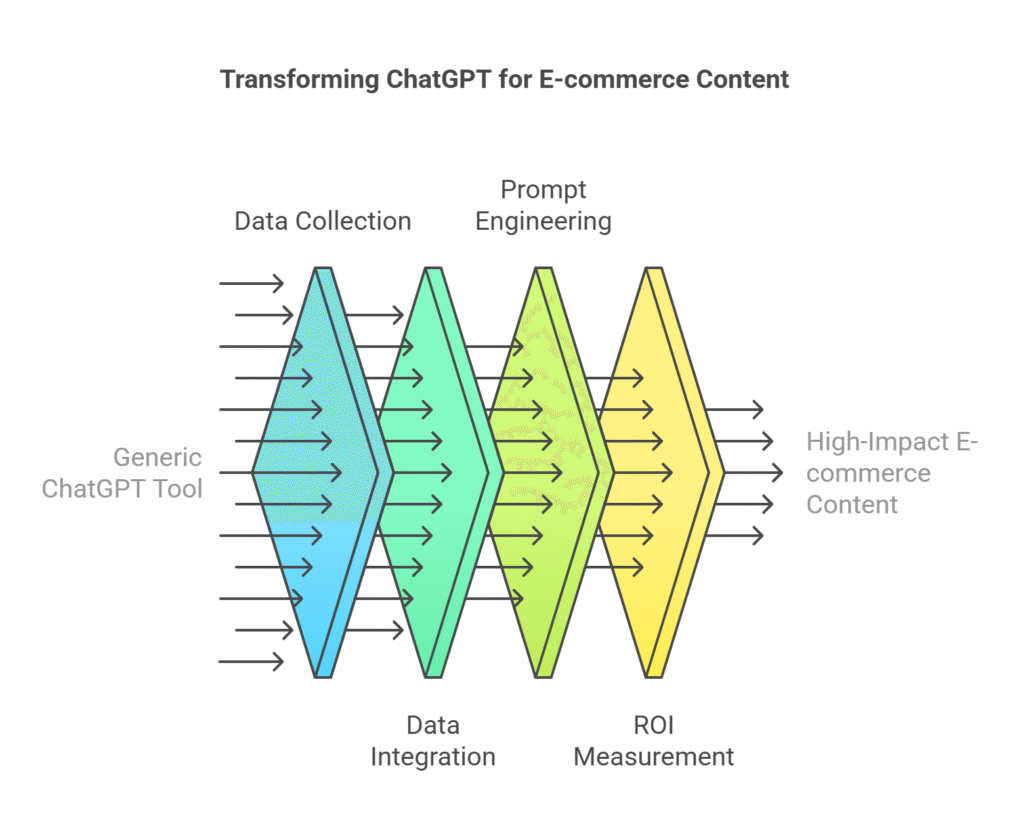
Table of Contents
The 5 Key Data Pillars for Feeding ChatGPT
To move beyond generic AI outputs, a consistent influx of relevant, high-quality data is essential. This “data diet” should encompass multiple facets of the customer experience and market landscape. Organizing data collection and processing around five key pillars ensures a holistic understanding that fuels more effective AI e-commerce content generation.
1. Voice of Customer (VoC)
Voice of Customer (VoC) data captures how your customers articulate their pain points, desires, expectations, and satisfaction. It’s the closest thing to a direct line into your customers’ minds and when used correctly, it can dramatically improve the relatability and performance of AI-generated content. AI enables powerful Voice of Customer analytics, helping brands uncover what customers really think.
ChatGPT is only as good as the data you feed it. Raw reviews and testimonials offer authentic, emotionally resonant language that no generic prompt can match.
Primary Sources:
- Product reviews on platforms like Okendo or Trustpilot
- Post-purchase and exit surveys (via Typeform, Delighted)
- Support interactions (Zendesk, Intercom)
- Transcripts of sales or support calls with customers
How to Use Okendo Reviews with ChatGPT: Export all customer reviews from Okendo. Ask ChatGPT to:
- Identify 2–5 recurring themes from the reviews
- Extract exact language customers use around those themes
- Generate ad angles or product page copy using those themes and language, acting as a performance-focused e-commerce copywriter
Prompt Example:
"Act as an expert advertising copywriter with over 15 years of expreince in the **niche** segment. Based on the uploaded reviews from our customers, identify 3 content themes, list the language customers are using, and write 5 Facebook ad hooks and headlines for each angle."Make sure that you refine your prompt to be as specific as possible.
Using this method, we identified that customers consistently mentioned how their skincare serum felt “lightweight” and “soaked in fast.” ChatGPT turned these into highly persuasive ad angles that increased ROAS by 22% over the previous creative batch.
| Data Source | Tool / Platform | Suggested Frequency |
|---|---|---|
| Customer Reviews | Shopify, Trustpilot, Okendo | Weekly |
| Post-Purchase Surveys (NPS, CSAT) | Delighted, SurveyMonkey | Monthly |
| Exit Surveys (Abandonment Reasons) | Hotjar, Feedbackify | Monthly |
| Support Tickets & Live-Chat Logs | Zendesk, Intercom | Weekly |
| “Why I Bought” / “Why I Almost…” | Typeform, Google Forms | Monthly |
| Video + Text Testimonials | Yotpo, VocalVideo | Monthly |
Leveraging Transcribed Calls for Unique Insights: One client recorded all sales and support calls and transcribed them weekly. They then prompted ChatGPT to:
- Find recurring customer objections and FAQs
- Identify underutilized emotional drivers in conversations
- Suggest messaging angles that hadn’t been tested before
This process revealed a new positioning angle, based on the customer’s fear of being “overwhelmed by complicated setups,” which we turned into an onboarding-focused campaign. The result? A 30% lift in conversion rates over the previous best-performing variation.
Cleaning & Tagging (Optional):
To ensure your VoC data is usable by AI tools like ChatGPT, it needs to be cleaned, categorized, and stored correctly.
- Redact PII: Use automated redaction scripts (e.g., with Python regex) or privacy compliance tools like Microsoft Presidio to remove personal identifiers (names, emails, phone numbers).
- Theme & Sentiment Tagging: Use lightweight tools like MonkeyLearn to classify each review or transcript line by sentiment (positive, neutral, negative) and by topic or product attribute (e.g., shipping speed, fit, customer support).
- Organize for Retrieval: Store this tagged data in a structured spreadsheet or Airtable. For larger brands, using a knowledge base or embedding-friendly system like Pinecone can help when scaling Retrieval-Augmented Generation (RAG) workflows.
AI Integration Tactics (Optional):
The cleaned and tagged VoC data serve as the foundation for two primary ChatGPT content workflows. These strategies are advanced and require expertise and dedicated time for implementation. While optional, they significantly enhance the quality of the data.
Fine-Tuning: Use cleaned JSONL examples to train ChatGPT on your brand voice.
- Retrieval-Augmented Generation (RAG):
- Convert reviews and call transcripts into embeddings using tools like OpenAI’s
text-embedding-ada-002model. - Store those embeddings in a vector database like Pinecone.
- During content generation (e.g., writing a product page), use a search query to fetch relevant customer insights, which are then embedded in the prompt to ground ChatGPT’s output in real language.
- Convert reviews and call transcripts into embeddings using tools like OpenAI’s
- Fine-Tuning:
- Curate a JSONL dataset of structured inputs (e.g., prompt: “Write ad copy for a shoe customers describe as ‘lightweight’ and ‘supportive'”) and outputs (your brand’s ideal copy).
- Upload this dataset to OpenAI for fine-tuning, helping the model adapt to your customer language and brand tone.
- Best suited for high-volume product catalogs or when you need ChatGPT to consistently reflect brand nuances across channels.
- RAG: Use a vector DB like Pinecone to retrieve relevant VoC insights per prompt
- Fine-Tuning: Use cleaned JSONL examples to train ChatGPT on your brand voice
VoC data doesn’t just inform your marketing, it writes it for you. When ChatGPT is grounded in real customer language, your content sounds more authentic, performs better, and unlocks messaging angles your competitors haven’t thought of.
2. Behavioral & Performance Data
While Voice of Customer data tells you what your customers are saying, Behavioral and Performance data tells you what they’re doing and what’s working.
This includes metrics tied to user behavior (clicks, scrolls, drop-offs) and campaign performance (CTR, conversions, bounce rates). Feeding these insights to ChatGPT allows it to replicate what converts and avoid what doesn’t.
AI-generated content is only as effective as the data it mirrors. Behavioral signals reveal to ChatGPT which headlines, subject lines, and layouts are actually effective.
| Metric | Tool / Platform | Suggested Export Frequency |
|---|---|---|
| Top/Worst Performing Ad Copy | Facebook Ads, Google Ads | Weekly |
| Email Open & Click-Through Rates | Klaviyo, Mailchimp | Weekly |
| Landing Page Heatmaps/Scrollmaps | Hotjar, Crazy Egg | Monthly |
| Funnel Drop-off Analytics | Google Analytics (GA4) | Weekly |
| Product Page Dwell Times | Google Analytics (GA4) | Weekly |
| Abandoned Cart Recovery Metrics | Shopify + Klaviyo | Weekly |
How to Use Performance Data with ChatGPT:
- Export Top and Bottom Performers
- Identify high-CTR ads, top-performing subject lines, or product pages with high time-on-page.
- Also pull underperforming examples for contrast.
- Feed ChatGPT a Summary
- Show ChatGPT examples of both high- and low-performing assets.
- Ask it to identify differentiators and generate new copy variations that emulate the winners.
- Create Prompt Templates for Ongoing Use
- Develop reusable performance-based prompt structures for ads, email subject lines, or product pages.
- Use Specific Performance Language
"Here are our top 5 ad headlines from Meta with their CTRs. Based on this, write 5 new headline variations that improve on our current average CTR of 3.2%."
Prompt Example:
Act as a direct response copywriter. Here are 3 of our best-performing ad headlines and their CTRs. Analyze their tone, structure, and appeal, then write 5 new Facebook ad headlines targeting fitness-conscious Gen Z women that aim for a CTR of 4%+.
Top Performers:
1. 'Sweat-Proof Style for Every Workout' – 3.8%
2. 'Feel Strong. Look Stronger.' – 4.1%
3. 'The Only Gym Shorts You'll Ever Need' – 3.9%"If you have data across multiple channels, prompt ChatGPT to identify patterns across mediums:
- “Do high CTR headlines share tone traits with high-converting email subject lines?”
- “What common language appears in our best-performing ads and longest dwell time product pages?”
We tracked email subject lines in Klaviyo and ad CTRs in Meta. By feeding ChatGPT the top 10 subject lines and ad headlines monthly, they generated optimized variations with targeted angles. Within 90 days, the abandoned cart emails achieved a 25% lift in CTR and their overall CPA dropped by 12%.
Behavioral Data for Friction Reduction:
Use drop-off and scroll data to inform AI-generated FAQs, microcopy, and page structure:
- “Write a reassuring bullet list addressing checkout hesitation. Users drop off at Step 3 (payment form) based on our Hotjar data.”
- “Based on scrollmap data, users aren’t reaching our product guarantee. Rewrite the section and move it higher in the page hierarchy.”
Key Integration Notes:
- Tag content types (e.g., ‘ad’, ’email’, ‘landing page’) to compare across formats.
- Centralize performance data in Looker Studio or Google Sheets.
- Use normalized metrics (CTR as %, bounce rate to 1 decimal) so AI can make sense of the data.
3. Brand-Customer Interaction Data
Beyond surveys and analytics, real-time conversations with your customers offer raw, unfiltered insights into objections, desires, and decision triggers. These interactions are gold for AI content generation, especially when it comes to writing copy that feels emotionally intelligent and naturally human.
Calls, chats, DMs, and comments reveal emotional nuance and real-world phrasing, providing ChatGPT with material to generate more conversational and persuasive content.
| Data Source | Tool / Platform | Suggested Frequency |
|---|---|---|
| Sales Call Transcripts | Chorus.ai, Gong | Weekly |
| Customer Interviews | Zoom + Otter.ai | Monthly |
| UGC & Influencer Comments | Brandwatch, Sprout Social | Ongoing/Monthly |
| DM Conversations/Comment Threads | Native Social APIs/Platforms | Daily/Weekly Dump |
| Internal Team Chat Notes (CX) | Slack, Microsoft Teams | Weekly Export |
How to Use Interaction Data with ChatGPT:
Use those insights to craft product pages, email sequences, or FAQ copy grounded in what customers are actually thinking and saying.ths. This demonstrates how interaction data can be used to preemptively address customer concerns in marketing content.
- Collect and Transcribe Conversations
- Record sales/support calls and convert them to text.
- Export live chat logs or social DMs manually or via API integrations.
- Ask ChatGPT to Surface Insights
- Identify recurring questions, hesitations, or praise.
- Extract emotionally charged language or overlooked objections.
- Generate Messaging from Real Interactions
- Use those insights to craft product pages, email sequences, or FAQ copy grounded in what customers are actually thinking and saying.
Prompt Example:
"Act as a CRO-focused copywriter. Analyze the following transcript from a support call. Extract the top 3 objections customers have before buying. Write a new email sequence that addresses these objections clearly and empathetically."Advanced Use Case — Emotional Copywriting:
Feed ChatGPT segments from sales calls where customers express doubts or aspirations:
- “I just want something that works without changing my entire routine.”
- “It’s hard to stay consistent.”
Ask ChatGPT to use this language in retention emails or testimonials. These are powerful cues for storytelling, hooks, and CTA phrasing.
Pro Tips for Integration:
- Summarize large volumes of data with ChatGPT before prompting content outputs.
- Use tags like ‘Objection,’ ‘Pain Point,’ ‘Goal’ to structure insights.
- Create a central “Voice Insights” document updated weekly to feed into prompt templates.
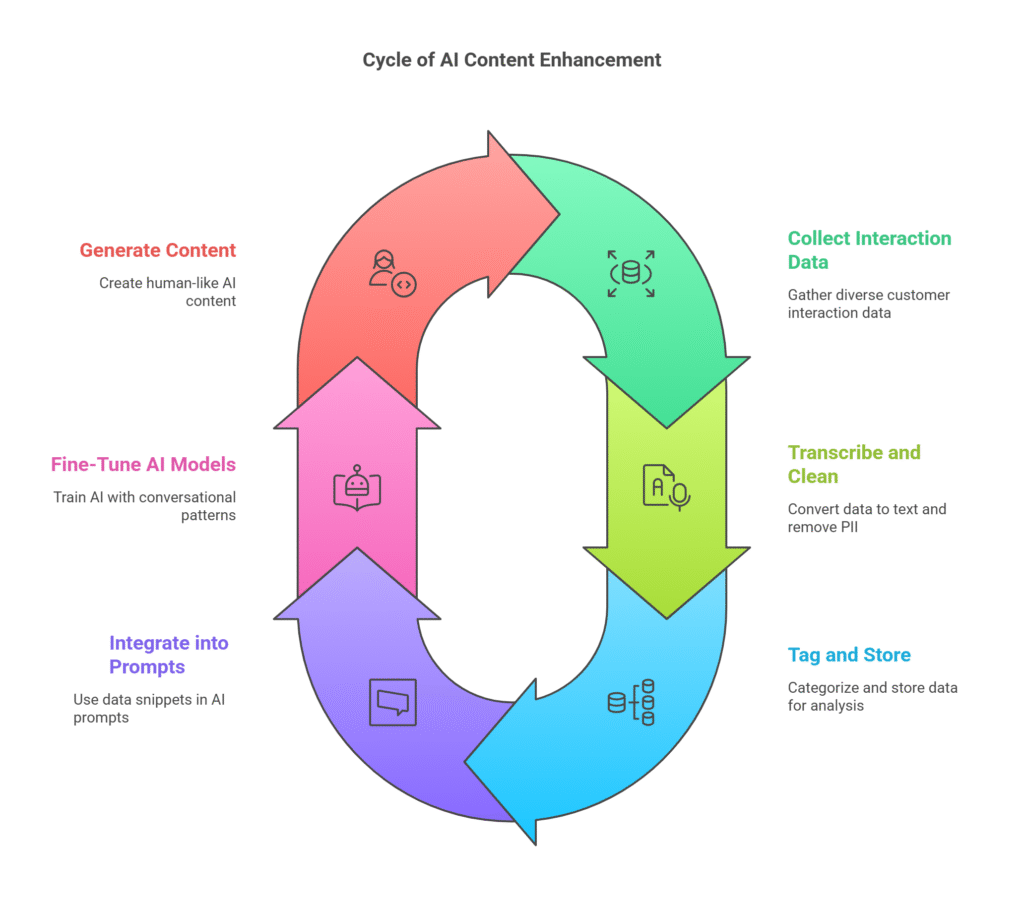
4. Psychographic & Identity Data
Psychographics go deeper than demographics; they reveal why your customers buy. This includes their values, beliefs, lifestyle preferences, goals, fears, and identity traits. When integrated into ChatGPT prompts, psychographic data enables emotionally resonant, persona-aligned messaging that feels tailor-made.
If you want ChatGPT to speak to your customers’ souls, you have to show it what they care about, fear, and aspire to.
| Data Source | Tool / Platform | Suggested Frequency |
|---|---|---|
| Goals & Fears Surveys | Typeform, SurveyMonkey | Monthly/Quarterly |
| Brand Archetype/Personality Quizzes | Playbuzz, Outgrow, Typeform | Quarterly |
| Metaphor/Pictorial Survey Responses | Visme, Google Forms, Miro | Quarterly |
| Lifestyle Segment Analytics (GA4) | Google Analytics | Monthly |
| Community/Forum Discussion Summaries | Reddit API, Discourse API, etc. | Weekly/Monthly |
How to Use Psychographics with ChatGPT:
- Create Persona Snapshots
Define archetypes such as “Eco-Minded Minimalist,” “Value-Seeking Parent,” or “Performance-Driven Gym-Goer.” Include:- Core values (e.g., sustainability, savings, results)
- Frustrations (e.g., greenwashing, overcomplicated tools)
- Lifestyle cues (e.g., busy professionals, weekend warriors)
- Prompt with Identity Cues
Feed persona traits into prompts to help ChatGPT adjust tone, emotional appeals, and cultural references.
Prompt Example:
"Write a product page for a daily multivitamin. Target the 'Wellness-Oriented Mom' persona: values simplicity, clean labels, and trustworthy brands. Avoid hype. Emphasize ease of use, kid-friendliness, and peace of mind."- Generate Psychographic Hooks
Ask ChatGPT to create ad hooks or email subject lines using language that taps into audience aspirations, goals, or insecurities.
Real-World Example: A health brand conducted a Typeform survey asking, “What’s your biggest struggle with staying consistent?” Top answers included: “I forget to take it,” and “I’m not sure it’s even working.” ChatGPT used this insight to develop testimonial-style copy focused on consistency, clarity, and visible progress — resulting in a 17% lift in email open rates and higher engagement.
Advanced Tip — Align With Archetypes: If your brand uses Jungian archetypes (e.g., The Explorer, The Caregiver, The Rebel), prompt ChatGPT to match voice and messaging:
"Use a tone consistent with 'The Hero' archetype. Write a launch email that positions our new gear as a way to conquer everyday challenges with confidence."Integration Tips:
- Create a Persona Library in Notion or Sheets for easy access.
- Update personas quarterly based on campaign learnings.
- Embed survey questions inside onboarding flows or post-purchase touchpoints.
Psychographic data enables deeper personalization. When ChatGPT understands who it’s engaging with, beyond just their purchases, it becomes significantly more persuasive.
5. External Cultural Signals
E-commerce doesn’t exist in a vacuum — your customers are shaped by what’s trending outside your brand. From viral TikTok formats to cultural moments and seasonal shifts, external signals provide powerful context for timely, relatable AI content.
When ChatGPT is trained on stale or isolated data, its content feels generic. Layering in cultural trends helps you stay relevant, reactive, and resonant.
| Signal Source | Tool / Platform | Suggested Frequency |
|---|---|---|
| Trending Social Media Topics/Sounds | BuzzSumo, TikTok Creative Center | Weekly |
| Viral TikTok/Instagram Comments | TokBoard, Brandwatch | Weekly |
| Competitor Reviews & Launches | Amazon API, Review Sites, Manual | Weekly/Ongoing |
| Pinterest Board Trend Analysis | Pinterest Trends | Monthly |
| Rising Search Queries | AnswerThePublic, Google Trends | Weekly |
| Industry News & Forum Discussions | Feedly, Reddit API, BuzzSumo | Daily/Weekly |
How to Use Cultural Signals with ChatGPT:
- Identify Timely Themes
Monitor TikTok trends, social hashtags, or news cycles that align with your product category. Log formats, phrasing, and emotional tones (e.g., “quiet luxury,” “lazy girl routine”). - Prompt ChatGPT to Align with Trends
Feed it examples of viral phrasing or influencer copy, then instruct it to generate new content in that style — without copying it outright.
Prompt Example:
"Act as a culturally aware DTC strategist. Based on current TikTok trends like 'hot girl walk' and 'clean aesthetic,' write 3 Facebook ad hooks for a wellness water bottle that use aspirational, minimalistic language."- Use Calendar Events to Trigger Timely Campaigns
- Earth Day, Back to School, Summer Fridays, or even viral news events can be embedded into ChatGPT prompts.
- Ask for time-sensitive creative tailored to moments when consumer attention spikes.
Advanced Use Case — Language Refresh:
- Every 4–6 weeks, audit your existing copy.
- Ask ChatGPT to rewrite stale product headlines using fresh phrasing aligned with the current audience vernacular.
Integration Tips:
- Maintain a rolling “Trends Bank” in Notion or Sheets.
- Add a cultural insight to every brief (“What’s trending that we can lean into?”)
- Have a lightweight creative review every 30 days to refresh tone and timing.
External signals are your shortcut to relevance. When ChatGPT reflects the world your customer lives in, it stops sounding like AI and starts sounding like someone they trust.
Addressing Data Gaps and Quality: The Hidden Bottleneck in Data-Driven AI Content
One of the most overlooked yet critical aspects of executing a high-performing ChatGPT e-commerce strategy is ensuring data quality and completeness. Feeding poor, sparse, or outdated data into your pipeline will undermine even the most advanced AI workflows.
AI-generated content is only as good as the raw data behind it. Inaccurate, missing, or unstructured inputs result in weak and irrelevant outputs.
This is particularly vital for teams pursuing data-driven AI content and AI content personalization, both of which rely on reliable, well-structured inputs.
Why It Matters
- Incomplete or inconsistent product data can lead to conversion-killing content gaps.
- Missing values (NaN, NULL, empty strings) can derail ChatGPT’s ability to reason, summarize, or personalize.
- Low-quality reviews or duplicate entries reduce the impact of VoC-based messaging.
Key Strategies to Ensure Clean, Usable AI Content Personalization Inputs
1. E-commerce Data Integration Data Audits
Regularly audit datasets across your five pillars — especially product catalogs, reviews, and survey responses. Look for:
- Missing attributes (e.g., price, fit, material)
- Inconsistent formatting (e.g., USD vs. $)
- Duplicate or irrelevant entries
2. Data Validation at Ingestion
Use tools like Zapier, Make, or ETL platforms (e.g., Fivetran) to set automated rules that validate data as it enters your system. Examples:
- Confirm survey responses aren’t blank
- Ensure product data has complete title/description/SKU
3. Handling Missing Values Smartly in your ChatGPT E-commerce Strategy
Not all missing data is equal:
- Use deletion only if sample size isn’t affected.
- Use imputation methods (mean, mode, ML-based) when keeping data is valuable.
- Be sure to differentiate between ‘zero’ (a value) and ‘null’ (missing).
4. Data Enrichment for E-commerce Data Integration
If you’re missing key details (like product specs or buyer attributes), AI can help suggest or auto-fill values using large-scale inference. Also consider:
- Third-party demographic enrichment APIs
- Product matching engines for similar SKUs
5. Synthetic Data (Use with Caution)
If you lack volume in specific segments (e.g., new product category), consider using generative AI to create simulated reviews or behavior patterns for training. Be aware of the risk of bias and the importance of marking this data for internal testing only.
6. AI-Driven Supplier Portals or PIM Systems for AI Content Personalization
For brands with large catalogs, consider using Product Information Management (PIM) platforms that integrate AI to:
- Auto-tag product data by attribute
- Standardize formatting from supplier uploads
- Flag low-quality or incomplete entries
E-commerce data integration doesn’t just mean collecting data; it means validating, cleaning, and preparing it so AI can use it effectively.
Run quarterly “Data Readiness Reviews” where your marketing and data teams assess whether current data quality is limiting AI output. This keeps your ChatGPT e-commerce strategy sharp and scalable.
Let’s explore pipeline architecture and how to activate your cleaned data for large-scale AI-driven e-commerce content generation. This process is vital for the success of any data-driven AI content strategy.
Building the Automated Data Pipeline: Activating E-commerce Data Integration
With high-quality data in place, the next step in your ChatGPT e-commerce strategy is enabling that data to flow into AI systems at scale. This is where an automated e-commerce data integration pipeline becomes crucial, ensuring your AI-powered e-commerce content engine is fueled by current, structured, and relevant data.
Core Components of an AI-Ready Pipeline
1. Data Ingestion
Connect to sources like:
- Shopify (product, order, customer data)
- GA4 (behavioral metrics)
- Zendesk (support tickets)
- Typeform (survey responses)
- Social platforms (comment scraping, API data)
Support for formats like JSON, CSV, XML, and APIs is essential.
2. Data Transformation
Prepare data through:
- Cleaning (remove PII, duplicates)
- Structuring unstructured text (tagging reviews, support tickets)
- Tagging by product attribute, theme, or sentiment
- Normalizing formats (dates, currency, language)
This makes it prompt-ready and consistent across tools.
3. Data Storage
Choose based on complexity and scale:
- Google Sheets: Lightweight, fast for prototyping
- Airtable: Good for tagging, filtering, visual pipelines
- Snowflake / BigQuery: Ideal for large-scale storage and analytics
- Pinecone / Weaviate: Vector DBs for embedding-based RAG search
4. Orchestration & Monitoring
Use platforms like Zapier, Make, Airbyte, or custom Python scripts to:
- Automate ingestion/transformation flows
- Monitor for pipeline failures
- Schedule batch jobs (e.g., weekly VoC sync)
3. Best Practices:
- Set Clear Objectives: Define what data is needed and why before building.
- Modular Design: Design the pipeline in distinct stages (ingest, transform, load) for easier maintenance and updates.
- Scalability: Choose tools and storage solutions that can handle future data growth (Snowflake/BigQuery generally scale better than Google Sheets for large volumes).
- Governance and Privacy: Integrate data validation, cleaning (PII removal), and quality checks throughout the pipeline. Adhere to privacy regulations (GDPR, CCPA). (See(#f-addressing-data-gaps-and-quality)).
- Monitoring & Alerting: Implement monitoring for pipeline failures, data latency, and quality issues.
- Data Security: Ensure secure data transfer and storage, using encryption and access controls.
Integrating Data with ChatGPT: RAG vs. Fine-Tuning for AI Content Personalization
With your data pipeline built, the next challenge is activating your e-commerce data integration inside ChatGPT workflows. There are two primary methods to accomplish this: Retrieval-Augmented Generation (RAG) and Fine-Tuning.
Option 1: Retrieval-Augmented Generation (RAG)
How it works: ChatGPT connects to an external knowledge base (e.g., cleaned product reviews, call transcripts, VoC data). At prompt time, relevant snippets are retrieved (via vector search) and embedded directly into the input context.
Use Case: Best for data-driven AI content that needs to reflect dynamic facts like trending reviews, recent FAQs, or live performance data.
Benefits:
- Up-to-date content without retraining the model
- Reduces hallucination by grounding in real data
- Scalable for large or frequently updated datasets
- Ideal for personalized copy, product pages, emails, and ad variations
Tools:
- Embedding:
text-embedding-ada-002, Cohere, or Hugging Face models - Vector DBs: Pinecone, Weaviate, FAISS
- Middleware: LangChain, LlamaIndex
Prompt Example:
"Act as an expert DTC copywriter. Based on the retrieved reviews for Product X — which frequently mention 'quick setup' and 'compact design' — write a 50-word Amazon bullet point list that addresses those themes in persuasive language."Option 2: Fine-Tuning
How it works: You upload a labeled dataset of prompts and ideal completions (typically in JSONL format) to teach ChatGPT your brand’s tone, format, and style. The model’s weights are adjusted to consistently output on-brand content.
Use Case: Best for reinforcing brand tone, persona-specific language, or formatting consistency in AI content personalization.
Benefits:
- Learns your brand voice and preferred style
- Produces consistently formatted output (e.g., PDPs, FAQs, CTAs)
- More efficient for bulk generation at scale
Considerations:
- Requires high-quality, well-labeled data (50–100+ examples minimum)
- Takes longer to train and retrain
- Less flexible to fast-changing data (use RAG for recency)
Best Practice:
- Use fine-tuning for style and tone
- Use RAG for fresh, factual data injection
- Combine both for layered intelligence (e.g., fine-tuned tone + real-time insights)
A hybrid strategy, fine-tuning the model on your historical content and grounding it with real-time data via RAG, delivers the highest-performing ChatGPT e-commerce strategy. A recent AWS case study showed that combining RAG and fine-tuning resulted in an 83 % jump in response quality.
Mastering Prompt Engineering: Turning Data into AI E-commerce Content
With your data integrated via RAG or fine-tuning, the next step is mastering the skill that converts that raw data into performance-driven content: prompt engineering.
Prompt engineering is where your ChatGPT e-commerce strategy comes to life, transforming structured data into engaging, high-converting copy at scale.
Why Prompt Engineering Matters for your ChatGPT E-Commerce Strategy
A well-engineered prompt:
- Makes use of your five data pillars (VoC, performance, psychographics, etc.)
- Aligns with your brand voice
- Guides the AI to create AI content personalization outputs that resonate and convert
But a vague prompt? It creates vague, generic results — even with perfect data.
Principles for High-Performance Prompt Design
1. Be Hyper-Specific Define your objective, format, audience, and tone clearly.
Instead of: “Write a product description”
Try: “Write a 100-word PDP description for our new organic skincare serum for Gen Z, using a playful and science-backed tone.”
2. Provide Context Embed VoC snippets, performance benchmarks, persona traits, or even previous campaign data.
3. Assign a Role Ask ChatGPT to act as a specific persona:
“Act as a CRO-focused copywriter who has optimized over 500 e-commerce PDPs for DTC skincare brands.”
4. Use Delimiters Structure prompts using ###, ---, or XML-style tags to help the model parse input vs. instruction.
5. Few-Shot Prompting Show examples of great outputs. This is especially powerful for training brand tone and structure.
6. Specify Format Be explicit: bullet points, JSON, markdown, etc.
7. Iterate Constantly Test, refine, and A/B your prompts. Use feedback loops to improve.
Example Prompt Using All Five Data Pillars
Act as: Expert Facebook Ads Copywriter for outdoor lifestyle brands
Goal: Write 3 headline options (max 40 characters each)
Product: 'TrailMax' Waterproof Hiking Boots
Persona: Adventure-Driven Millennial (Values: Durability, Sustainability, Confidence)
Data Insights:
VoC: Reviews highlight 'all-day comfort' and 'grip on slippery trails'
Performance: Best CTR (4.1%) was for “Built for the Wild” headline
Interaction: Chat logs show frequent concern about “winter traction”
Psychographics: Customers identify as “weekend explorers”
Cultural Signal: Rise in #WinterHiking TikTok trend
Instructions:
Use VoC quotes to anchor comfort/trust
Mention grip/traction for winter confidence
Reflect the cultural trend subtly
Stay within 40 charactersOutput:
- Weekend-Proof. Trail-Tested.
- Winter Grip. Zero Slips.
- Comfort That Climbs With You
The Prompt → Performance Loop
Prompt engineering isn’t “set and forget.” Top e-commerce brands create feedback loops:
- Track content performance (CTR, ROAS, Conversion Rate)
- Identify winning elements (headline length, keywords, tone)
- Adjust prompt frameworks accordingly
- Test variants in controlled experiments
Measuring Impact: Proving the ROI of Your Data-Driven AI E-commerce Content
Launching an AI-powered content strategy takes time, tools, and talent. To ensure that investment pays off, your team needs to move beyond vague output metrics (e.g., number of product descriptions generated) and measure real business outcomes. The true value of data-driven AI content is revealed in its conversion lift, efficiency gains, and attributed revenue.
Key ROI Metrics to Track
1. Conversion Rate Uplift
Compare product pages, landing pages, or emails using AI-generated content vs. human-written content. Use A/B tests to isolate results.
2. Engagement Metrics
Look for:
- Increased time on page
- Decreased bounce rate
- Higher scroll depth on PDPs
3. Attributed Revenue
Measure sales influenced by:
- AI-generated ads
- Personalized email flows
- Tailored PDPs using VoC and performance data
4. Creative Efficiency
Calculate:
- Time saved per asset (PDP, ad copy, etc.)
- Cost reduction from outsourcing less to freelancers
- Volume of content produced per week/month
5. Customer Experience Metrics
Track shifts in:
- NPS (Net Promoter Score)
- CSAT (Customer Satisfaction)
- Support ticket volume from clearer product info
6. Marketing Efficiency
Monitor ROAS, CPA, and CTR for campaigns using AI-enhanced messaging, and benchmark against previous baselines.
Build a Performance Dashboard
Use Looker Studio, Tableau, or your eComm BI tool to:
- Connect GA4, Shopify, Facebook Ads, and Klaviyo
- Tag AI-influenced content via UTM or CMS fields
- Visualize trends in CTR, conversion, and revenue tied to AI copy
Pro Tip: Tag content by prompt structure, data pillar used, or ChatGPT version to isolate top performers.
ROI Calculation Framework
Use this formula to assess overall performance:
ROI (%) = ((Value Generated – Cost of Implementation) / Cost of Implementation) x 100Example:
| Value Area | Estimate |
| Conversion Uplift | +$5,000/month |
| Time Saved | +$2,500/month |
| Ad Creative Savings | +$1,000/month |
| Tooling Costs | -$700/month |
| Human Prompting Time | -$1,200/month |
| Net Benefit | +$6,600/month |
| ROI | (6,600 / 1,900) x 100 = 347% |
Create a Continuous Optimization Loop
Monthly AI Content Reviews should:
- Audit performance by content type and data pillar
- Identify top-performing prompt structures
- Retire low-performing templates
- Feed successful content back into fine-tuning datasets
- Update RAG indexes with new VoC or reviews
ROI compounds when you treat data, prompts, and performance as part of a closed-loop learning system.
Conclusion: Activate Your Data-Driven ChatGPT E-commerce Strategy
This guide outlines a comprehensive and actionable framework for transforming how e-commerce and DTC brands create content using ChatGPT, not by relying solely on AI, but by providing it with structured, relevant, and customer-centered data.
By systematically collecting and operationalizing insights across the five key data pillars, Voice of Customer, Behavioral & Performance, Customer Interactions, Psychographics & Identity, and Cultural Signals, you can turn a general-purpose LLM into a high-performing, specialized AI e-commerce content engine.
The true transformation lies in combining:
- Automated, scalable e-commerce data integration
- RAG and fine-tuning workflows tailored to your goals
- Precision-built prompts that reflect what your customers actually care about
- Continuous ROI tracking that drives ongoing optimization
Start Small, Scale Strategically
Don’t try to operationalize every data pillar at once. Begin with the most accessible — typically VoC and performance data — and build from there. Use tools like Zapier or Airtable to automate early wins before scaling to platforms like Snowflake or Pinecone.
Treat prompt engineering as a dynamic process, not a static instruction. Test. Learn. Iterate. Over time, your AI outputs will evolve alongside your data and brand maturity.
The Competitive Edge in 2025 and Beyond
The e-commerce brands that win tomorrow won’t be the ones merely using AI. They’ll be the ones feeding it the right data, with the right structure, for the right task, turning personalization into performance at scale.
As AI capabilities accelerate, so does the need for responsible data governance. Ensure your workflows comply with GDPR, CCPA, and best practices in AI ethics, particularly when handling customer insights.
By implementing a ChatGPT e-commerce strategy grounded in real data, you’re not just producing content; you’re building an intelligent, scalable content flywheel that improves with every cycle.
The future of content is not limited to AI-generated content. It’s data-driven, performance-tuned, and continuously learning. Now you have the roadmap to make it real.
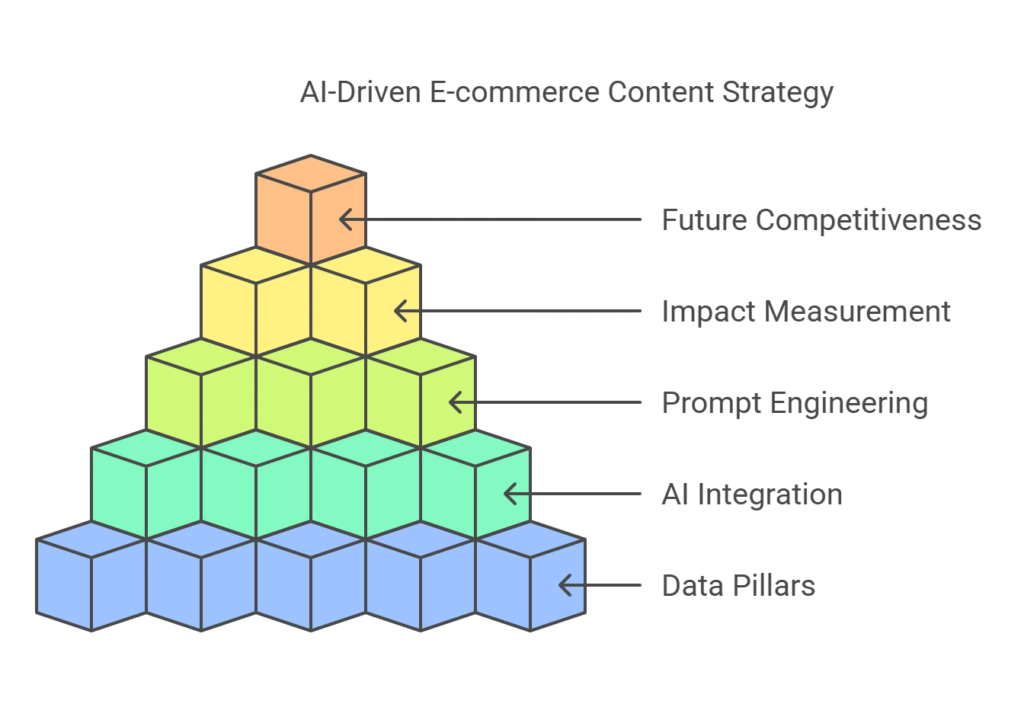
Frequently Asked Questions (FAQ)
How can I make ChatGPT generate better AI e-commerce content?
To generate better e-commerce content, you need to feed ChatGPT structured, context-rich data, not just general prompts. This includes customer reviews, sales call transcripts, performance data, and audience insights. The more specific your inputs (via prompt engineering or data retrieval), the more relevant and persuasive the output.
What kind of data should I feed ChatGPT for e-commerce strategy?
The most effective data comes from five sources:
–Voice of Customer (VoC) — Reviews, surveys, transcripts
– Performance Data — High-converting ads, email metrics, CTRs
– Brand-Customer Interactions — FAQs, objections, support chats
– Psychographics — Buyer personas, values, and motivators
– Cultural Signals — Trends, seasonality, social listening
Feeding this into ChatGPT improves accuracy, tone, and conversion potential.
What’s the difference between RAG and fine-tuning in ChatGPT?
– RAG (Retrieval-Augmented Generation) fetches real-time data and injects it into prompts. It’s great for keeping AI outputs grounded in current facts (like recent reviews or FAQs).
– Fine-Tuning involves training the model on your branded content style. It’s better for long-term consistency in tone and formatting.
Many brands use both in tandem for best results.
How do I know if my AI-generated content is working?
Track content performance using:
– Conversion rates (A/B test AI vs. human copy)
– Engagement metrics (bounce rate, scroll depth)
– Revenue attribution (AI ad campaigns or email flows)
– ROI benchmarks (compare savings and revenue vs. tool/human cost)
Use dashboards like Looker Studio or Tableau to monitor and tag AI-powered content across campaigns.
5. Can I use ChatGPT to write product descriptions?
Yes, but only if it has relevant data. To write high-performing product descriptions, ChatGPT should be prompted using:
– Customer language (from reviews)
– Top-performing ad copy themes
– Audience pain points and motivators
– Desired tone, format, and features
The best outputs result from combining structured inputs with detailed, clear prompt instructions

